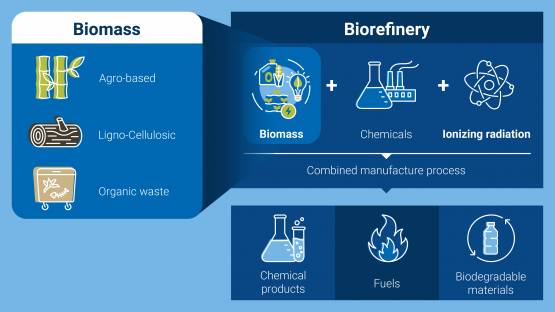The IAEA is calling on research institutes to join its new Coordinated Research Project (CRP) aimed at strengthening the use of biomass for synthesis of bioplastics and other compounds using radiation technology. The project, entitled Strengthening the Use of Biomass for Synthesis of Bioplastics and Other Compounds, Using Radiation Technology, is an activity under the IAEA’s NUclear TEChnology for Controlling Plastic Pollution (NUTEC Plastics) initiative.
Biomass, being largely composed of natural polymers, is a renewable matter from animal or vegetable origin which can be used for bioenergy, bioplastics, and other compound production.
Conventional biomass processing methods and routes usually involve a high energy intake along with solvent or catalyst addition. The process is long and does not efficiently break down recalcitrant biomass materials. At the same time, the trends show an increasing demand of biopolymers and chemical intermediates for 2030, while biofuels and others are required constantly.
Radiation processing is a recognized, versatile and efficient tool for obtaining task-specific functional polymers suitable for a variety of applications. Nevertheless, there are challenges in applying radiation technology and natural polymer together.
This 5-year CRP will focus on the radiation processing (gamma ray, electron beam, and X ray treatments) of biomass feedstocks (from agriculture, forest, marine or by/waste product sources) to provide new bio-based and biodegradable plastic solutions, and increase the use of these renewable resources for bioenergy and other chemical compound production. In addition to its scientific and technological benefits, this approach will also contribute to meeting the Sustainable Development Goals (SDGs) related to affordable and clean energy (SDG7), industry innovation and infrastructure (SDG9), and responsible consumption and production (SDG12).
CRP Objectives
The CRP is aimed at strengthening the use of radiation technology for natural and biodegradable polymer modification to obtain bioplastics with task-specific functionalities suitable for a variety of applications, reducing the fossil fuel-based single use plastics as well as enhancing the biomass availability for energy purposes.
Specifically, it is aimed at
- Functionalizing natural and biodegradable polymers with emphasis in replacing single use plastic and petrol-based packaging materials.
- Integrating radiation technologies into biorefineries to improve the yield, quality, or variety of consumer products.
Expected Outcome and Results
The Coordinated Research Project is expected to enhance capabilities of Member States in the application of radiation techniques (radiation-induced reactions for polymer modification initiated by gamma ray, electron beam, and/or X ray), to increase the use of biomass for bioenergy, bioproducts and intermediate compounds. It is also expected to help design and develop pilot biorefineries.
Among the concrete results expected of the project are
- Radiation-mediated process established for bioenergy applications or bio-based products/intermediates,
- Harmonized protocols for synthesizing and testing,
- Networking researchers and establishing partnerships in biorefinery application by using radiation.
- High quality publications (by IAEA and in scientific journals) and outreach materials.
How to join the CRP
Research organizations interested in joining the CRP must submit their Proposal for Research Contract or Agreement by e-mail to the IAEA’s Research Contracts Administration Section, by 10 March 2023, using the appropriate template on the CRA web site. The IAEA encourages institutes to involve, to the extent possible, female researchers and young researchers in their proposals. For further information related to this CRP, potential applicants should use the contact form under the CRP page.




